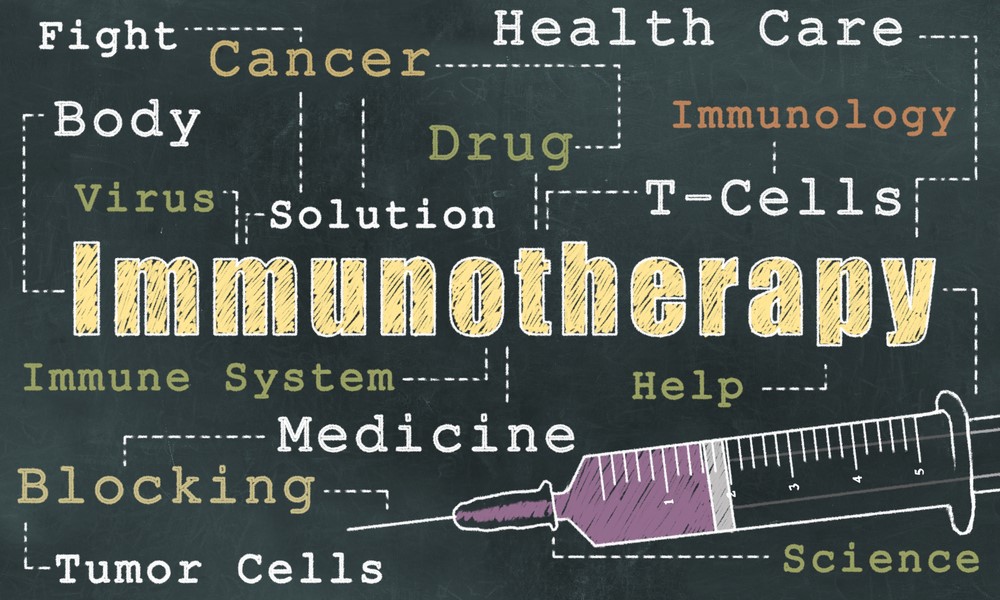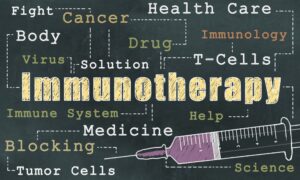Immunotherapy and Cancer

 By: Jim Rudman. Our immune systems are our built-in protection against infections and diseases, including cancer. Immune cells, as well as the elements they produce, travel throughout the body. When they come across a foreign substance, such as germs and bacteria, proteins produced by cancer cells, etc., they attack it.
By: Jim Rudman. Our immune systems are our built-in protection against infections and diseases, including cancer. Immune cells, as well as the elements they produce, travel throughout the body. When they come across a foreign substance, such as germs and bacteria, proteins produced by cancer cells, etc., they attack it.
While a healthy immune system can fight off many diseases, targeting cancer is much more difficult. Viruses, bacteria, allergens, and toxins come from outside the body and are easily recognized. Cancer cells start in normal cells, and then mutate, so the immune cells may not perceive cancer cells as invaders. When they do perceive the danger, they might not be strong enough for that particular cancer cell. Furthermore, cancer cells can give off their own substance to protect themselves from being found.
It’s beginning to sound like a war, and it is. Hence the field of oncology and immunotherapy. Among other research, scientists are continually seeking ways to help our immune systems to recognize, destroy, and obliterate cancer cells. Immunotherapy treatments work in several ways. They may stimulate the immune system to fight off cancer, attack the cancer cells directly, or prevent cancer from coming back after treatment. Currently, vaccines, T-cell infusions, and utilizing antibodies to bind and inhibit cancer-producing proteins are all practiced. However, Cancer.org reports that “New immunotherapy treatments are being tested and approved, and new ways of working with the immune system are being discovered at a swift pace.”
In the same report, cancer.org shares several main types of cancer-treating immunotherapy:
- Checkpoint inhibitors: These drugs take the ‘brakes’ off the immune system, which helps it recognize and attack cancer cells.
- Chimeric antigen receptor (CAR) T-cell therapy: This therapy takes some T-cells from a patient’s blood, mixes them with a particular virus that makes the T-cells learn how to attach to tumor cells, and then gives the cells back to the patient so they can find, adhere to, and kill cancer.
- Cytokines: This treatment uses cytokines (small proteins that carry messages between cells) to stimulate the immune cells to attack cancer.
- Immunomodulators: This group of drugs generally boosts parts of the immune system to treat certain types of cancer.
- Cancer vaccines: Vaccines are substances put into the body to start an immune response against certain diseases. We usually think of them as being given to healthy people to help prevent infections. But some vaccines can help prevent or treat cancer.
Note: cancer vaccines are used to prevent disease, such as the HPV vaccine, or to treat cancer directly (tumor cell vaccines, antigen vaccines, dendritic cell vaccines, or vector-based vaccines).
- Monoclonal antibodies (mAbs or MoAbs): These are human-made versions of immune system proteins. mAbs can be very useful in treating cancer because they can be designed to attack a specific part of a cancer cell.
- Oncolytic viruses: This treatment uses viruses that have been modified in a lab to infect and kill specific tumor cells.
There are other immunotherapies, including adoptive T-cell transfer, donor lymphocyte therapy (DLI), radioimmunotherapy, and virus immunotherapy.
With every type, the ultimate goal is to rebuild/restore the immune system, helping it kill cancer cells and stop cancer from spreading. It can treat various types of cancer, such as leukemia, lymphoma, breast cancer, prostate cancer, lung cancer, bladder cancer, and melanoma. The FDA already approves multiple immunotherapies, and more are still being tested in clinical trials –for almost all other types of cancer.
Depending on the type and stage of cancer, some patients may be treated with immunotherapy alone, while others may receive it in conjunction with other therapies.
It is administered in various ways, depending on the type of immunotherapy, cancer, and in some cases, the patient. It may be given topically, orally, by injection, or intravenously. Sometimes it is administered directly into a body cavity.
As with many drugs and therapies, immunotherapy comes with potential side effects.
One of these is a fever. Consider this: When we have an infection, our body temperature rises, and we have a ‘fever.’ A fever helps our immune system speed up its ability to fight illness and respond to the invading germs quicker. Higher body temperatures make it harder for bacteria and viruses to thrive in the body. So, when immunotherapy essentially ‘revs up’ and stimulates our immune system, it is not uncommon to develop a fever. Other side effects can include chills and flu-like symptoms, including body aches, nausea, and vomiting. Loss of appetite and fatigue are also potential side effects.
Of course, immunotherapy isn’t the answer for every case, and the harm it can bring to body systems and organs must be taken into consideration with the patient’s oncologist. However, in the war against cancer, immunotherapies can be a formidable weapon. It may work when other options, such as radiation and chemotherapy, don’t, increase the success rate when used in conjunction with other therapies, produce fewer side effects, and ultimately prevent cancer from returning.





